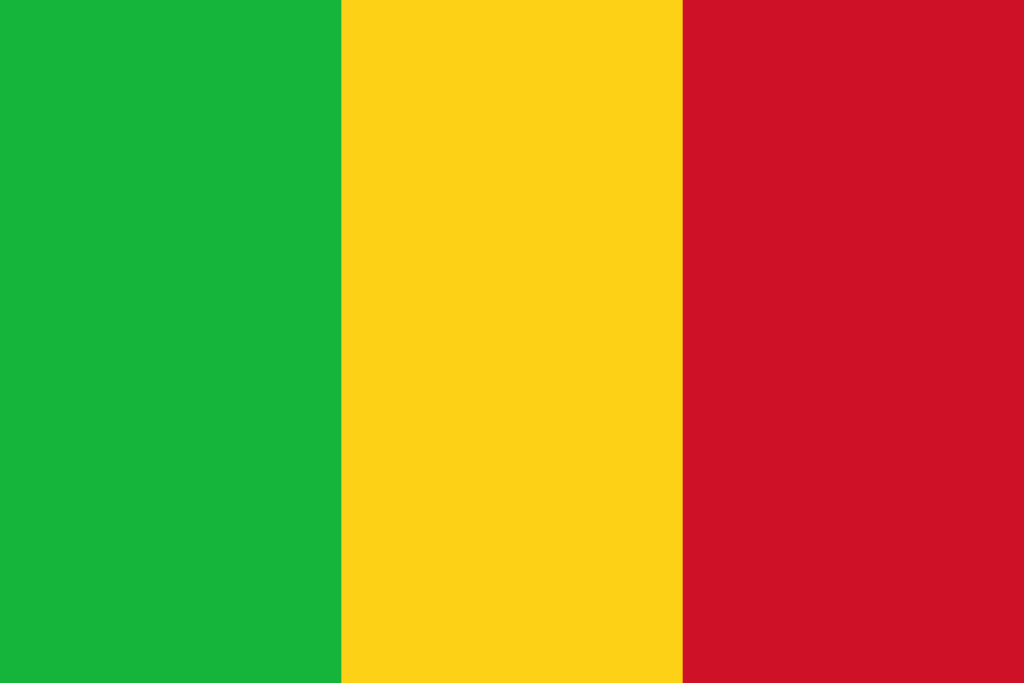The flag of Mali is a tricolor design, composed of three vertical stripes of equal width stretching from the flagpole (hoist) side to the opposite end (fly). These stripes, colored green, yellow, and red, each hold profound symbolism that reflects Mali's rich history, culture, and aspirations.
Green Stripe:The leftmost stripe, a vibrant green, serves as a vivid representation of Mali's multifaceted identity and deep-rooted heritage.
It embodies the fertile, verdant lands of Mali, particularly in its southern regions, where agriculture flourishes. This hue signifies not only the nation's agricultural prosperity but also underscores the pivotal role of farming in its economic fabric.
A subtle nod to Islam, Mali's predominant religion, is captured within the green stripe. This symbolism acknowledges the integral role that Islam plays in the lives of Malian people and their cultural tapestry.
Beyond its religious connotations, green also encapsulates the themes of hope, growth, and the untouched natural beauty of Mali's diverse landscapes.
Yellow Stripe:Positioned at the center, the yellow stripe holds a wealth of historical, cultural, and geographical significance, reflecting Mali's intricate past and diverse geography.
The yellow evokes the vast Sahara Desert, which stretches across a significant expanse of Mali's northern territories. This color pays homage to the stark beauty of the desert landscapes and acknowledges their importance in Mali's geographic makeup.
A poignant representation of Mali's historical legacy is seen in the yellow stripe, drawing from the grandeur of the ancient Malian Empire. This empire, famed for its opulence and intricate gold trade networks, places Mali firmly on the global historical stage.
Yellow embodies unity and solidarity among Mali's diverse populace, celebrating the harmonious coexistence of various ethnicities and cultures despite their differences.
Red Stripe:The rightmost stripe, a bold red, carries profound symbolism that resonates with Mali's struggles, resilience, and aspirations for a better future.
Red embodies the sacrifices and struggles endured by the Malian people during their fight for independence and liberation from colonial rule. It serves as an enduring tribute to the countless individuals who laid down their lives to secure the nation's sovereignty.
Symbolic of courage, strength, and determination, red reflects the unwavering resolve of the Malian people in overcoming challenges and building their nation from the ground up.
The red stripe serves as a testament to the collective spirit and dedication of Mali's citizens, highlighting their shared commitment to a brighter and more prosperous future.
Historical Context:Officially adopted on March 1, 1961, the Malian flag stands as a potent emblem of the nation's emergence from French colonial dominance. It symbolizes Mali's assertion of autonomy and self-expression, as it sought to carve out its distinct identity on the global stage. The meticulous selection of colors and symbolism encapsulates Mali's historical narratives, geographical diversity, cultural heritage, and forward-looking aspirations.
In essence, Mali's flag is a visual tableau that intricately weaves together historical echoes, cultural threads, religious influences, and geographical landscapes. It reverberates with the echoes of Mali's past while casting an unwavering gaze toward a future characterized by unity, prosperity, and resilience.
Last Updated on: November 13, 2025
